Finding The Good In Every Season
“Embrace the Suck.” My youngest son is a Naval aviator. He was given that sage advice during Plebe Summer at the Naval Academy in Annapolis. Translation: try to turn any negative into a positive. Look for the good – in everything.
I know, easier said than done in 2020.
A few friends are dreading the upcoming winter, due to an unsavory convergence of virus, political-storms
and inevitable ice and wind chill. My solution: vow to practice physical distancing, no matter what the weather. Walking, sledding, cross country skiing.
Bundle up, embrace the chilly suck!
A dry outlook into much of next week may help with outdoor chores and field work. And I see more opportunities to take the boat out. ECMWF predicts 70s next week, with a shot at 80F by Tuesday and Wednesday. This weekend looks dry; Sunday the milder day with low 70s. Classic weather for September.
Meanwhile, Hurricane Teddy may impact Maine (!) next week, while “Wilfred” strafes the Gulf Coast from Corpus Christi to New Orleans. Cue the Greek Alphabet for naming hurricanes.
I’m OK with our cool fronts.
Trending Milder Into December? Even with a developing La Nina cool phase of the Pacific? Hey, it’s 2020 – anything can happen, but NOAA CPC (Climate Prediction Center) is showing a mild bias for the entire nation looking out the next 3 months.

Praedictix Briefing: Issued Thursday morning, September 17th, 2020:
Tropical Depression Sally
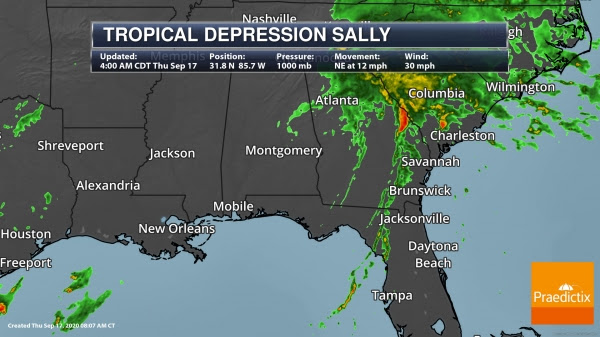
Sally Weakening. While Sally has quickly weakened over the past 24 hours as the system continues to move inland, it is still producing heavy rain across portions of the Southeast this morning. As of 4 AM CDT, the center of Sally was 50 miles southeast of Montgomery, AL, and moving northeast at 12 mph. Sally had winds of 30 mph.
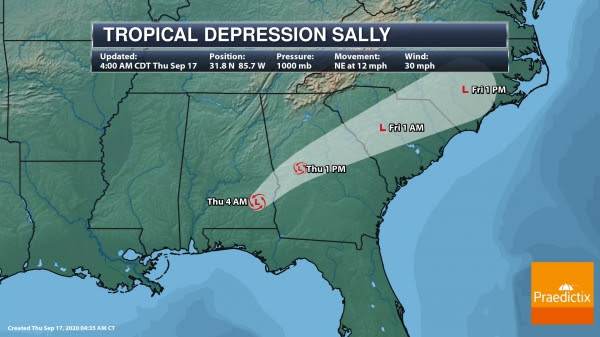
Sally Track. This is the last forecast track that the National Hurricane Center will be issuing on Sally as the system continues to weaken. The center of Sally is expected to be across portions of Georgia by the early afternoon hours and move over the Carolinas late tonight into Friday. Additional weakening is expected, and Sally should become a remnant low by tonight or Friday.
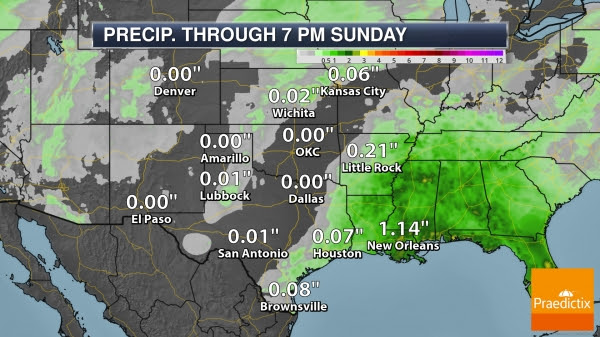
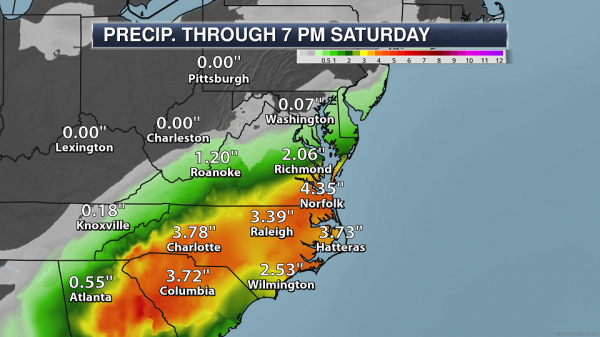
Additional Heavy Rain. The main risk with Sally will continue to be heavy rain across portions of the Southeast and Mid-Atlantic states through the end of the week. Here are expected rainfall totals from the National Hurricane Center:
- Central Georgia: Sally will produce additional rainfall totals of 3 to 6 inches, with localized higher amounts, on top of 3 to 6 inches which has already fallen. Widespread flash flooding and minor to moderate river flooding is likely.
- Central to upstate South Carolina: 3 to 6 inches, with isolated amounts of 10 inches. Widespread flash flooding and minor to moderate river flooding is likely.
- Western to central North Carolina into south-central and southeast Virginia: 4 to 6 inches, isolated amounts up to 8 inches. Flash flooding and widespread minor river flooding is likely.
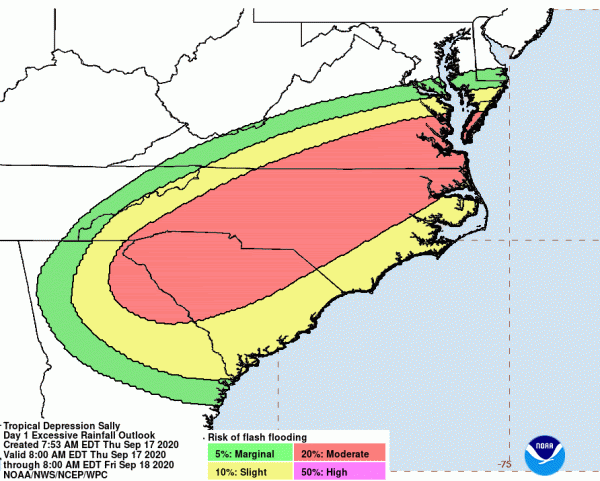
Flooding Expected. Even as Sally continues to move to the east-northeast across the Southeast today, flooding can still be expected across the Southeast and Mid-Atlantic today with a Moderate Risk of flash flooding in place. In these areas, 3-5” amounts with isolated 8” totals will be possible.
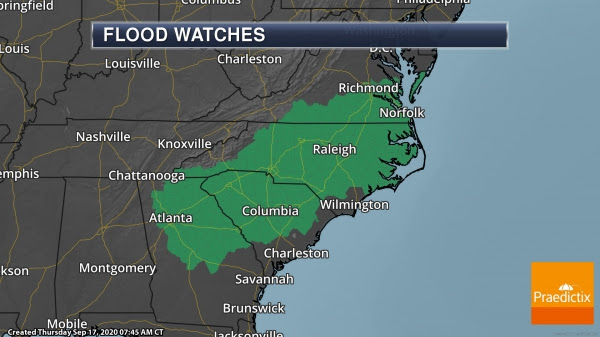
Flood Watches. Flood Watches continue to extend from Georgia to southern Virginia due to Sally and the expected rain with the system over the next few days.
Other Tropical Activity
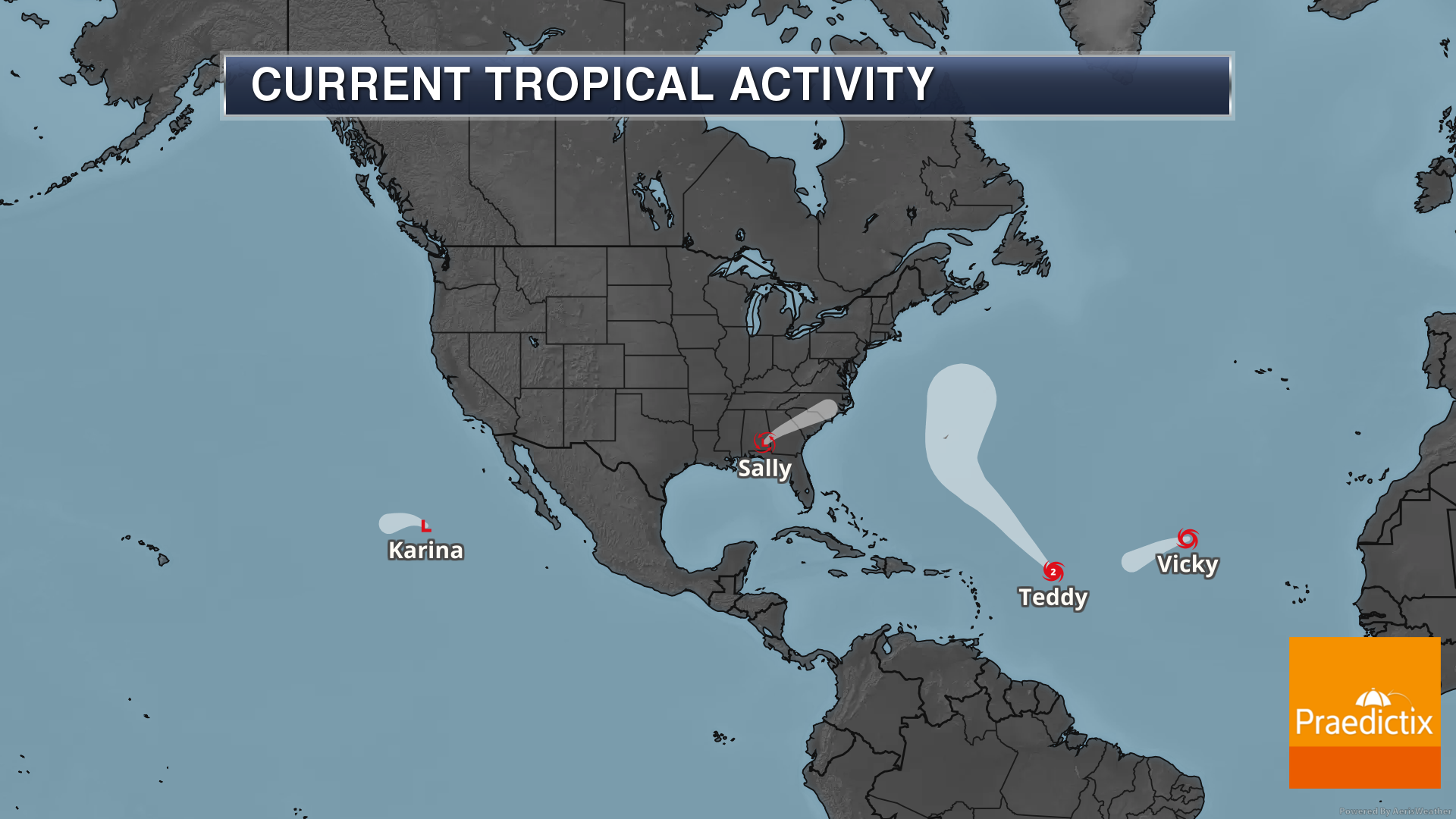
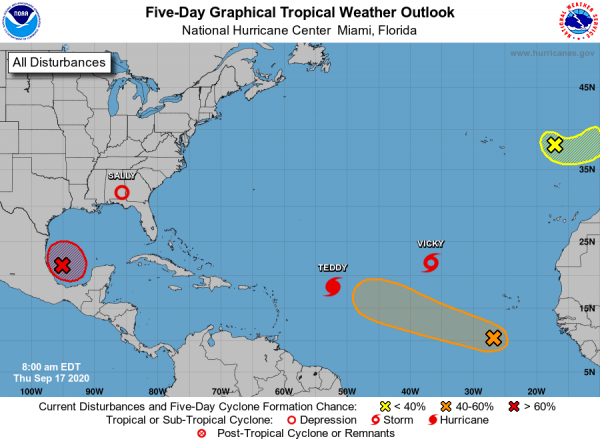
Other Tropical Activity. We are also watching the following systems in the Atlantic:
- Hurricane Teddy: Teddy is continuing to strengthen, up to 105 mph winds as of this morning, and is expected to become a major hurricane by Friday. Some weakening will occur later this weekend, but Teddy is expected to still be a hurricane as it impacts Bermuda late this weekend into early next week.
- Tropical Storm Vicky: Vicky is expected to weaken into a tropical depression later today out in the Atlantic and continues to pose no threat to land.
- An area of low pressure in the southwestern Gulf of Mexico continues to become better organized, and a tropical depression or storm could form later today. The low will meander over the southwestern Gulf of Mexico for the next day or two before slowly moving northward toward the weekend. This system has a 90% chance of formation in the next 48 hours.
- The low we have been tracking out toward the Cabo Verde Islands remains elongated and disorganized. It still has a chance for development in the next couple of days before upper level winds increase helping to make conditions less favorable for development into the weekend. It has a 40% chance of formation in the next two days with a 50% chance in the next five days.
Western Wildfires
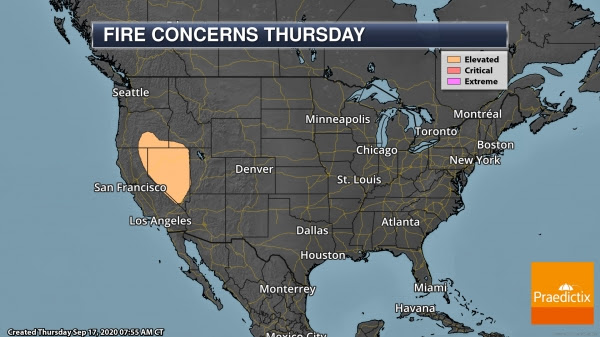
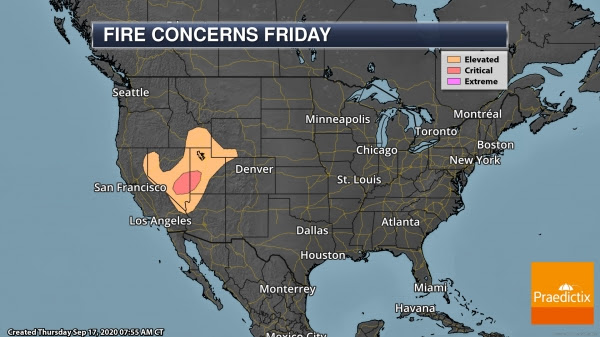
Fire Danger Today And Friday. We continue to track fire weather conditions across the western United States the next couple of days. Today an elevated fire danger is in place from Oregon and California into the Great Bain due to stronger wind gusts in combination with the continuing dry conditions across the region. Stronger winds are possible Friday due to a low deepening in the northern Rockies and ahead of a cold front across portions of Nevada and Utah where a critical fire danger is in place.
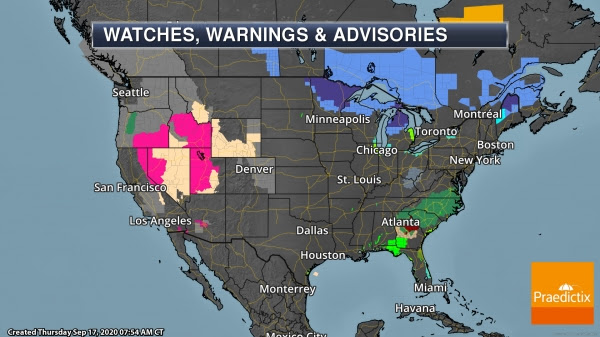
Fire Danger And Air Quality Concerns. Fire Weather Warnings (pink) and Fire Weather Watches (tan) are in place across portions of the western United States due to the fire danger over the next few days. Air Quality Alerts (gray) remain in place across the western United States due to the smoke from the wildfires reducing air quality across the region. These now stretch as far east as the Front Range. We are also watching Flash Flood Watches today/tonight across portions of Oregon as heavy rain is expected that could cause flash flooding and debris flows in recently burned areas, including around the Riverside, Beachie Creek, Lionshead, and Holiday Farm Fires.
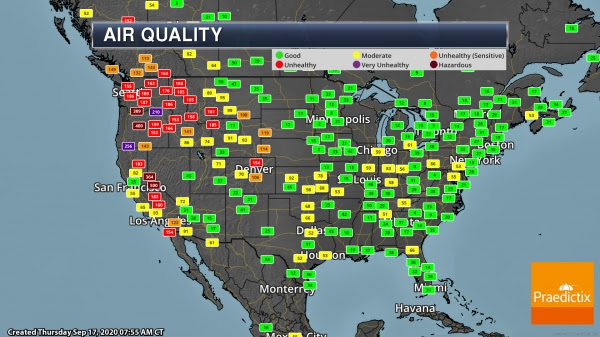
Hazardous Air Quality This Morning. We continue to track unhealthy to hazardous air quality across portions of the western United States due to all the wildfire smoke in the air.

Air Quality Forecast. Unhealthy to hazardous air quality is expected to continue across the region today. Hazardous air conditions will be possible in the Spokane, Portland, Salem, Medford, and Pomona areas.
D.J. Kayser, Meteorologist, Praedictix.
Warm Enough For Tropical Systems in the Mediterranean Sea. I dread the day a hurricane approaches Rome or Athens. Far-fetched? I thought so, too. Image credit from Thursday: AerisWeather AMP.
Medicane “Lanos”. Tropical systems in the Mediterranean Sea? Yep. Here’s an overview of the system pushing into southern Greece from Severe Weather Europe: “A Mediterranean tropical-like cyclone – Medicane Ianos has developed over the Ionian Sea and is moving towards western Greece. A severe impact is increasingly likely. Ianos will bring destructive winds, torrential rainfall, tornadoes, and flooding across parts of Greece…A Mediterranean tropical-like cyclone – Medicane Ianos has developed over the Ionian Sea and is moving towards western Greece. A severe impact is increasingly likely. Ianos will bring destructive winds, torrential rainfall, tornadoes, and flooding across parts of Greece...”
Hottest Summer on Record. Minnesota experienced the 4th warmest and 17th wettest meteorological summer on record. For a broader scope Climate Central has details: “…Summer 2020’s heat is one for the record books. It was the fourth-hottest summer on record for the contiguous U.S. and third-hottest June-August period globally. Many cities in the Southwest, Southeast, Mid-Atlantic, and Northeast either broke or tied their records for their hottest summer to date. Investigating this further, Climate Central uncovered that summer 2020 was within the top 10 hottest summers for 37% (452) of 1,203 cities analyzed, and 55 cities had their hottest summer on record…”
Tracking Smoke. NOAA has an online tool that pinpoints fire locations and smoke. Yesterday’s orange sun was a direct result of the massive amount of smoke being thrown off by western fires.
The Most Important Number for the West’s Hideous Fire Season. I did not know this; more analysis from The Atlantic: “...The vapor-pressure deficit indexes two other measurements: the air temperature and the relative humidity. Both measurements affect the air’s sponginess. Hotter air is more likely to bump water into a gas state, while drier air can hold more water vapor overall. The vapor-pressure deficit measures the overlap. “It’s the difference between the amount of water vapor that’s in the air and the amount of water vapor that the air can possibly hold,” Williams said. When the vapor-pressure deficit is high, it means the atmosphere has become an immense, six-mile-high sponge. The arid air will induce water to evaporate from wherever it’s hiding—the soil, the wooden boards of houses, the limbs and leaves of trees and underbrush...”
Graphic credit: “The vapor-pressure deficit in August in California, as calculated by Park Williams.”
5 Ways to Help Victims of West Coast Fires. Mental Floss has some timely links: “Wildfires continue to ravage millions of acres across California, Oregon, and Washington, and strong winds forecasted in some of those regions could aggravate the blazes. To prevent future fires, we need to focus on combating climate change through policy reform and sustainable living. But for people directly affected by the fires, their current needs are much more urgent: food, shelter, and funds. Here are five organizations that can help you help victims...”
File image credit: American Red Cross.
“The California Compromise”. Fewer people are California-dreaming these days, due to an accumulation of disasters. The Washington Post (paywall) reports: “…This is the latest iteration of the California Dream, a Gold Rush-era slogan meant to capture the hopeful migration of an old nation to a new, rich West. For generations, the tacit agreement for California residents resembled a kind of too-good-to-be-true deal. Live in the lovely if often drought-plagued Sierra, or beneath the beachfront Pacific Coast cliffs, and work in an economy constantly reinventing itself, from Hollywood to the farms of the San Joaquin to Silicon Valley. But for many of the state’s 40 million residents, the California Dream has become the California Compromise, one increasingly challenging to justify, with a rapidly changing climate, a thumb-on-the-scales economy, high taxes and a pandemic that has led to more cases of the novel coronavirus than any other state...”
File image: Paul Douglas.
The Most Likely Way You’ll Get Infected With Covid-19. How become become ill is becoming more clear – and avoidable, according to a timely post at Medium Elemental: “…A clear example of the benefits of masks is a recent outbreak in South Korea, in which one woman at a Starbucks infected 27 other customers — whom officials assume were not wearing masks because they were eating and drinking — but none of the employees, all of whom were masked the entire time. Aerosol transmission does increase the importance of one additional protective step, which is proper ventilation and air filtration. Airflow, either introducing new air into a room or filtering the existing air, can disperse and dilute any infectious aerosol particles, reducing a person’s potential exposure. Being outdoors is the ultimate ventilation, and for months public health officials have recommended that people socialize outside rather than in. However, with winter and colder temperatures coming, indoor air filtration and adherence to masks will become even more important...”

These are America’s 20 Worst Cities to Drive In. No kidding. Mental Floss makes an argument for public transportation; here’s an excerpt: “...For their report on the worst cities for drivers in 2020, the personal finance website compared 100 of the biggest cities in the country across 31 different metrics. The criteria they looked at included average gas prices, annual hours spent in traffic per commuter, and auto-repair shops per capita. Oakland, California, ranked top on the list of worst, largely thanks to the high cost of car ownership and maintenance rates in the Bay Area. It was followed by Philadelphia, which has some of the worst traffic and driving infrastructure of any U.S. city. San Francisco, Detroit, and New York City rounded out the bottom five...”
Exclusive: The Billionaire Who Wanted To Die Broke…Is Now Officially Broke. Forbes has an amazing story; here’s an excerpt: “…His stark generosity and gutsy investments influenced Bill Gates and Warren Buffett when they launched the Giving Pledge in 2010—an aggressive campaign to convince the world’s wealthiest to give away at least half their fortunes before their deaths. “Chuck was a cornerstone in terms of inspiration for the Giving Pledge,” says Warren Buffett. “He’s a model for us all. It’s going to take me 12 years after my death to get done what he’s doing within his lifetime.” Feeney gave big money to big problems—whether bringing peace to Northern Ireland, modernizing Vietnam’s health care system, or spending $350 million to turn New York’s long-neglected Roosevelt Island into a technology hub. He didn’t wait to grant gifts after death or set up a legacy fund that annually tosses pennies at a $10 problem. He hunted for causes where he can have a dramatic impact and went all-in...”
58 F. high yesterday in the Twin Cities.
71 F. average high on September 16.
88 F. high on September 16, 2019.
September 17, 1997: An F3 tornado destroys several buildings and damages numerous others. Hundreds of trees are knocked down. A number of cattle are also killed in a collapsed barn. One man is injured when the tornado engulfs his car and throws it into a nearby woods. A second man is critically injured when his garage collapses, then dies several weeks later. The total path length of the tornado from 1 NE of Lastrup to Onamia is 17 miles. Total property damage is estimated at $1.7 million. In total, 6 tornadoes touch down in Morrison, Mille Lacs, and Kanabec.
September 17, 1991: Duluth gets 2.5 inches of snow five days before the beginning of Fall.
September 17, 1971: A brush fire at Lake Alexander in Morrison County spawns a 10-foot wide, 50-foot high ‘fire whirl.’ It moved out over the lake, overturned a 1,800 pound pontoon boat, and then dissipated as it moved back to shore.
September 17, 1903: 3.75 inches of rain falls in the Minneapolis area.
FRIDAY: Partly sunny, cool. Winds: SE 5-10. High: 61
SATURDAY: Patchy clouds, breezy. Winds: S 10-15. Wake-up: 49. High: 69
SUNDAY: A little nicer. More sun, milder. Winds: S 10-20. Wake-up: 56. High: 74
MONDAY: Stray early shower, then sunshine. Winds: S 7-12. Wake-up: 58. High: 78
TUESDAY: Sunny, warm and pleasant. Winds: S 5-10. Wake-up: 61. High: 81
WEDNESDAY: Warm sun, late T-storm possible. Winds: S 10-15. Wake-up: 63. High: near 80
THURSDAY: A few clouds, cooler breeze. Winds: NE 10-15. Wake-up: 61. High: 74
Climate Stories…
Why Hurricane Sally is Moving So Slowly – And Delivering Epic Rainfall. Much like Harvey and Florence, Sally’s extremely slow forward movement prolonged heavy rains along the Gulf Coast, where over 30″ was reported in some locations. National Geographic has more details: “…Emerging research is showing that the climate crisis will make storms move more slowly and higher temperatures will allow them to carry more water. One paper published in 2018 showed that hurricanes around the world were already moving about 10 percent slower on average than they did before 1950. Warmer temperatures also make hurricanes rainier. Warm air is able to hold more water vapor, and historic rainfall like Hurricane Harvey produced in Houston, Texas, has been linked to climate change...”
Image credit: “On Monday morning, a NOAA satellite identified five storm systems in the Atlantic and one in the Pacific Ocean. It was the first time since 1971 that five named storms were in the Atlantic Basin at the same time.” Photograph courtesy NOAA.
New Studies Confirm Weakening of the Gulf Stream Circulation (AMOC). Here’s a timely post from RealClimate: “Many of the earlier predictions of climate research have now become reality. The world is getting warmer, sea levels are rising faster and faster, and more frequent heat waves, extreme rainfall, devastating wildfires and more severe tropical storms are affecting many millions of people. Now there is growing evidence that another climate forecast is already coming true: the Gulf Stream system in the Atlantic is apparently weakening, with consequences for Europe too. The gigantic overturning circulation of the Atlantic water (dubbed AMOC) moves almost 20 million cubic meters of water per second – almost a hundred times the Amazon flow. Warm surface water flows to the north and returns to the south as a cold deep current. This means an enormous heat transport – more than a million gigawatts, almost one hundred times the energy consumption of mankind. This heat is released into the air in the northern Atlantic and has a lasting effect on our climate…”
Map credit: “Diagram of the Gulf Stream system with the warm surface current and the cold deep current. The actual Gulf Stream off the US coast is a part of this more comprehensive circulation system. The color shading shows the measured temperature trend since the late 19th century. This diagram is based on Caesar et al., Nature 2018 and first appeared in the Washington Post.”
Business Roundtable Endorses Market-Based Climate Policy. POLITICO reports: “The Business Roundtable, a major trade association that includes the heads of some of the largest and most influential companies in the U.S. as members, is endorsing a “market-based mechanism” as part of a plan to sharply curb greenhouse gas emissions that cause climate change, The move, which was first reported by POLITICO on Tuesday, throws the lobbying voice of those executives from companies with $7 trillion in annual revenues behind efforts to combat climate change, reflecting a stark division between the business community and the Trump administration...”
Biogen Launches $250 Million Plan to Eliminate Fossil Fuel Emissions. WRAL’s TechWire has the story: “Neuroscience pioneer Biogen, with manufacturing in RTP, has drawn an aggressive line in the sand in support of the environment. The company just announced a $250 million, 20-year initiative – Healthy Climate, Healthy Lives – to eliminate fossil fuel emissions across all its operations by 2040. As part of that effort, the company also will seek out global research collaborations to tackle the effects of fossil fuel-driven air pollution on public health. “Our Healthy Climate, Healthy Lives initiative builds on Biogen’s long-standing strategy to deal with climate change by addressing the interrelated challenges of climate and health, including the realm of brain health,” said company CEO Michel Vounatsos...”
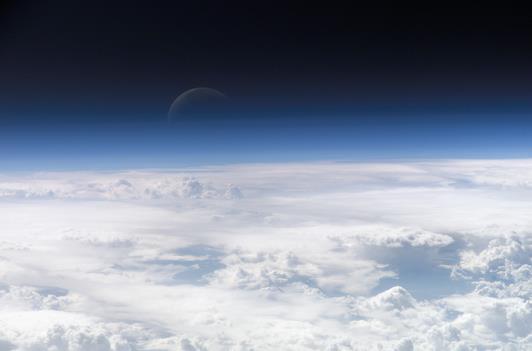
Getting to Net-Zero Emissions Could Cost $2 Trillion a Year, ETC Report Says. But the cost of inaction may be a multiple of that number, according to a post at CNN.com: “Achieving net zero greenhouse gas emissions by 2050 is possible but will cost $1 trillion to $2 trillion a year, according to a new report, which warns that the cost of unmitigated climate change will be much higher. The Energy Transitions Commission, a coalition of senior executives from 45 energy producers, financial institutions and environmental groups, said Wednesday that it is “technically and economically possible” to achieve net zero emissions by the middle of the century at an annual cost of about 1% to 1.5% of global GDP…”
File image: NASA.
Climate Change is Now Killing Birds in Midair. Gizmodo Earther has the details: “…Scientists aren’t yet sure what’s causing this mass bird death, but researchers at Cornell University’s ornithology lab suspect it has to do with the smoke from the historic wildfires burning in the western U.S., which has drifted across the country on easterly breezes. They cite a 2017 study, which shows that exposure to smoke can lead to immunosuppression, respiratory distress, and other severe health problems for avian populations. Another possibility is that the birds may be having trouble adapting to the unusually dry heat that the Southwest has seen of late amid the worsening climate crisis. These conditions can be unfavorable to the insect populations that migratory birds rely on for food, which studies show has caused bird populations to decrease...”
File image: Wikipedia.

How Fast is the Climate Changing? It’s a New World, Each and Every Day. Here’s an excerpt of an essay at The New Yorker: “…Floods and fires are obvious and dramatic. But this extra energy is expressing itself every second of every hour, usually quietly; you may not notice it, but eventually an ice shelf collapses or a heavy downpour turns into a monster flood. It’s relentless, and it means that we live in a new world, newer all the time. For almost all of human history, the atmospheric concentration of carbon dioxide stuck at about two hundred and seventy-five parts per million, meaning that the planet’s energy balance was essentially unchanged. The physical world worked in predictable ways. But there’s around twenty-five parts per million more CO2 in the air now than there was a decade ago: That’s more change in ten years than over all the millennia from the invention of agriculture to the start of the Industrial Revolution…”
File image: NASA.
How Climate Migration Will Reshape America. The New York Times details the trends and predictions as more Americans try to get out of the way of some of the most extreme weather phenomena: “…In all, Hauer projects that 13 million Americans will be forced to move away from submerged coastlines. Add to that the people contending with wildfires and other risks, and the number of Americans who might move — though difficult to predict precisely — could easily be tens of millions larger. Even 13 million climate migrants, though, would rank as the largest migration in North American history. The Great Migration — of six million Black Americans out of the South from 1916 to 1970 — transformed almost everything we know about America, from the fate of its labor movement to the shape of its cities to the sound of its music. What would it look like when twice that many people moved? What might change?...”
Map credit: Rolling Stone.
Climate Change Will Force a New American Migration. Note to self – it’s already happening. ProPublica examines the threat and subsequent trends in where Americans want to live: “…What I found was a nation on the cusp of a great transformation. Across the United States, some 162 million people — nearly 1 in 2 — will most likely experience a decline in the quality of their environment, namely more heat and less water. For 93 million of them, the changes could be particularly severe, and by 2070, our analysis suggests, if carbon emissions rise at extreme levels, at least 4 million Americans could find themselves living at the fringe, in places decidedly outside the ideal niche for human life. The cost of resisting the new climate reality is mounting. Florida officials have already acknowledged that defending some roadways against the sea will be unaffordable. And the nation’s federal flood-insurance program is for the first time requiring that some of its payouts be used to retreat from climate threats across the country. It will soon prove too expensive to maintain the status quo…”
Hurricane Sally Is a Slow-Moving Threat. Climate Change Might Be Why. A story at The New York Times (paywall) connects the dots: “…Climate change has made hurricanes wetter and slower, scientists have found. Recent research suggests that global warming — specifically in the Arctic, which is warming much more rapidly than other regions — is playing a role in weakening atmospheric circulation and thus potentially affecting hurricane speed. A 2018 study found that since the middle of the 20th century, translation speeds of all hurricanes and tropical storms had decreased by about 10 percent. Another study that year that focused on Atlantic hurricanes found that the average speed of storms near the North American coast had slowed by more than 15 percent…”
September 15, 2020 visible image credit: NOAA and AerisWeather.
Hurricane Sally’s Slow Movement – a Link to Climate Change? Here’s an excerpt from CNBC.com: “…The pace of tropical storms making landfall has slowed during the last several decades. The lingering creates worse rainfall and flooding. North Atlantic hurricanes specifically have been moving slower and stalling more frequently over the past even decades, according to research by NASA and the National Oceanic and Atmospheric Administration. Other research suggests that warming in the Arctic has weakened atmospheric circulation, which is likely affecting hurricane speed by causing a slowing of the jet stream. “Our own work suggests that climate change is favoring precisely such jet stream behavior,” said Michael E. Mann, a climate scientist at Penn State and an author of the report...”
Climate Crisis: 11,000 Scientists Warn of “Untold Suffering”. Sadly, many of those stories of suffering are already being told, this week along the Gulf Coast and the western U.S. Here’s a clip from The Guardian: “The world’s people face “untold suffering due to the climate crisis” unless there are major transformations to global society, according to a stark warning from more than 11,000 scientists. “We declare clearly and unequivocally that planet Earth is facing a climate emergency,” it states. “To secure a sustainable future, we must change how we live. [This] entails major transformations in the ways our global society functions and interacts with natural ecosystems.” There is no time to lose, the scientists say: “The climate crisis has arrived and is accelerating faster than most scientists expected. It is more severe than anticipated, threatening natural ecosystems and the fate of humanity…”
File photo credit: “A man uses a garden hose to try to save his home from wildfire in Granada Hills, California, on 11 October 2019.” Photograph: Michael Owen Baker/AP.
Scientific American Endores Joe Biden. I haven’t seen this before. Scientific American explains: “Scientific American has never endorsed a presidential candidate in its 175-year history. This year we are compelled to do so. We do not do this lightly. The evidence and the science show that Donald Trump has badly damaged the U.S. and its people—because he rejects evidence and science. The most devastating example is his dishonest and inept response to the COVID-19 pandemic, which cost more than 190,000 Americans their lives by the middle of September. He has also attacked environmental protections, medical care, and the researchers and public science agencies that help this country prepare for its greatest challenges. That is why we urge you to vote for Joe Biden, who is offering fact-based plans to protect our health, our economy and the environment…”
Illustration credit: Ross MacDonald.
Conservative Media and Trump Dismiss Climate Change as Cause of Fires. The New York Times (paywall) has perspective on right wing media amplifying climate denier talking points: “Rush Limbaugh told millions of his radio listeners to set aside any suggestion that climate change was the culprit for the frightening spate of wildfires ravaging California and the Pacific Northwest. “Man-made global warming is not a scientific certainty; it cannot be proven, nor has it ever been,” Mr. Limbaugh declared on his Friday show, disregarding the mountains of empirical evidence to the contrary. He then pivoted to a popular right-wing talking point: that policies meant to curtail climate change are, in fact, an assault on freedom. “Environmentalist wackos” — Mr. Limbaugh’s phrase — “want man to be responsible for it because they want to control your behavior,” the conservative host said on the show…”


